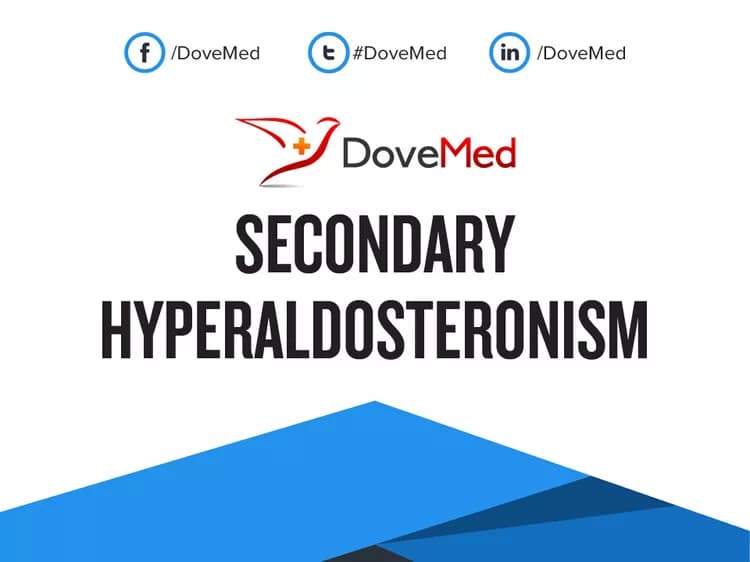What are the other Names for this Condition? (Also known as/Synonyms)
- Secondary Aldosteronism
What is Secondary Hyperaldosteronism? (Definition/Background Information)
- Hyperaldosteronism is a condition in which the adrenal gland releases too much of the hormone called aldosterone. The normal function of aldosterone is to maintain adequate levels of potassium and sodium in blood and also to regulate the blood pressure
- When too much of this hormone is produced, fluid levels increase in the body due to the excess loss of potassium and retention of sodium. The increased fluid levels result in a higher blood pressure
- When this condition is caused by factors outside of the adrenal gland, it is referred to as Secondary Hyperaldosteronism
- Secondary Hyperaldosteronism is dependent upon the underlying causative factors and can occur at any age. It is mainly caused by a reduced blood flow to the kidneys with resultant overproduction of aldosterone
- The condition results in signs and symptoms such as fatigue, numbness, muscle weakness, high blood pressure, and blurring of vision. Secondary Hyperaldosteronism could result in complications that include kidney damage with resultant failure, heart attack, and stroke
- Treatment and prevention of Secondary Hyperaldosteronism depends upon the underlying causative factor. The underlying causes determine the prognosis of the condition
Who gets Secondary Hyperaldosteronism? (Age and Sex Distribution)
- Secondary Hyperaldosteronism can occur at any age depending upon the underlying causative factors
- It has shown a higher prevalence among women than men
- The condition is observed worldwide; all racial and ethnic groups are at risk
What are the Risk Factors for Secondary Hyperaldosteronism? (Predisposing Factors)
The risk factors for Secondary Hyperaldosteronism may include:
- Alcohol abuse
- High blood pressure
- Enlarged heart
It is important to note that having a risk factor does not mean that one will get the condition. A risk factor increases ones chances of getting a condition compared to an individual without the risk factors. Some risk factors are more important than others.
Also, not having a risk factor does not mean that an individual will not get the condition. It is always important to discuss the effect of risk factors with your healthcare provider.
What are the Causes of Secondary Hyperaldosteronism? (Etiology)
Secondary Hyperaldosteronism is typically caused by a reduced blood flow to the kidneys leading to excess aldosterone production. The causes of reduced kidney blood flow may include:
- Obstruction of the renal artery or renal artery stenosis
- Heart failure
- High blood pressure
- Cirrhosis of the liver - chronic liver disease with scarring of the liver tissue
- Nephrotic syndrome - when kidneys leak essential proteins leading to body swelling and low protein levels in blood
What are the Signs and Symptoms of Secondary Hyperaldosteronism?
The common signs and symptoms associated with Secondary Hyperaldosteronism include:
- Numbness
- Fatigue
- Hypokalemia - abnormally low levels of potassium in blood
- Blurred vision
- High blood pressure (that does not decrease in response to medication)
- Paralysis
- Excessive thirst
How is Secondary Hyperaldosteronism Diagnosed?
The diagnosis of Secondary Hyperaldosteronism may include:
- The physician will undertake a full medical history as well as conduct a complete physical exam
- During physical exam, he/she may look for high blood pressure, swelling, and retinal abnormalities
There are many tests and imaging techniques that can be used to determine hormone over production. The common tests and procedures include:
- CT scan of the abdomen
- Serum potassium and electrolyte level test
- Plasma renin activity: Elevated levels are present in Secondary Hyperaldosteronism
- Glucose tolerance test
- Urinary aldosterone level test
- Plasma aldosterone level test
- Insertion of catheter into the adrenal gland veins to check the levels of aldosterone (in the vein)
- ECG to check electrical activity of the heart, because abnormally low levels of potassium affect the heart rhythm
Many clinical conditions may have similar signs and symptoms. Your healthcare provider may perform additional tests to rule out other clinical conditions to arrive at a definitive diagnosis.
What are the possible Complications of Secondary Hyperaldosteronism?
The complications associated with Secondary Hyperaldosteronism include:
- Kidney damage and kidney failure
- Heart attack
- Heart failure
- Stroke
- Dementia
How is Secondary Hyperaldosteronism Treated?
- Treatment of Secondary Hyperaldosteronism depends on the underlying cause
- The management of the underlying causative factor will result in the correction of Secondary Hyperaldosteronism
How can Secondary Hyperaldosteronism be Prevented?
- Prevention of Secondary Hyperaldosteronism depends upon the underlying causative factors
- Appropriate treatment of causative factors on time may prevent the occurrence of this condition
What is the Prognosis of Secondary Hyperaldosteronism? (Outcomes/Resolutions)
The prognosis of Secondary Hyperaldosteronism is variable and depends on the cause of the condition.
Additional and Relevant Useful Information for Secondary Hyperaldosteronism:
When excess amounts of aldosterone are released due to a disorder of the adrenal gland itself, it is referred to as primary hyperaldosteronism.
Related Articles
Test Your Knowledge
Asked by users
Related Centers
Related Specialties
Related Physicians
Related Procedures
Related Resources
Join DoveHubs
and connect with fellow professionals


0 Comments
Please log in to post a comment.